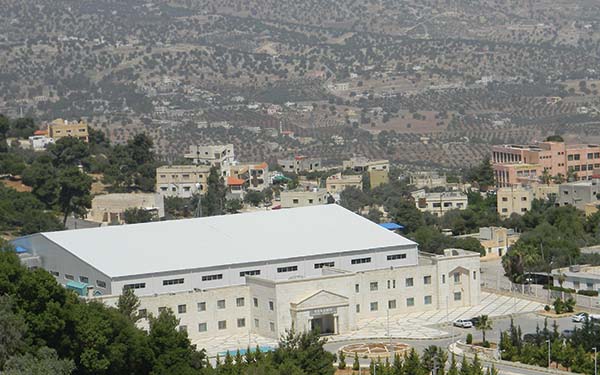Maedeh Darzi studies brittle, stained fragments of animal skin — centuries-old pieces of the Quran, Torah and poetry books, for example — by beaming infrared light at them. This method allows researchers to figure out the chemical composition of archaeological artifacts without having to cut them up.

The SESAME laboratory in Allan, Jordan, about 35 km outside the capital of Amman.
Photo courtesy of SESAME
"We can find out how they made parchment or how they made ink," said Darzi, a chemist at the Institute for Research in Fundamental Sciences in Tehran, Iran. Her experiments, she hopes, will unlock secrets from a vibrant past while helping museums preserve the materials for posterity.
The catch: She needs an expensive machine known as a synchrotron to produce the infrared light.
In the past, Darzi used a synchrotron in Italy. But since last year, with the opening of a $110 million facility called SESAME in Allan, Jordan, she has the opportunity to run some of her experiments without having to ship fragile samples across continents.
The centerpiece of SESAME (the acronym stands for Synchrotron-Light for Experimental Science and Applications in the Middle East) is its ring-shaped synchrotron. Dozens of low-field magnets along the ring’s 133-meter circumference help the synchrotron produce light by accelerating electrons. When those magnets bend and push the electrons close to the speed of light, the particles emit electromagnetic radiation, or light.
At SESAME, those intense beams are deflected into one of several tunnels known as a beamline, which is where Darzi would place a parchment sample for study. By observing where the parchment reflects and absorbs the light, Darzi can identify distinct chemicals in the material. For example, she plans to use synchrotron light to study the extent to which collagen from the animal skins has broken down.
SESAME is starting off with two beamlines, one infrared, another X-ray, and plans to add two more in the next year. Scientists from many disciplines have big plans for this light: Tel Aviv University biophysicist Roy Beck intends to study the structure of neurons using the X-ray beam, for example. Archaeometrist Jan Gunneweg of the Hebrew University of Jerusalem wants to study 2,000-year-old incense from the region. Eventually, SESAME's light could be used to study crystal structure in new materials.
The loftiest goal of the facility is to foster peace in the region. SESAME's eight member states, all in the Middle East, contribute to its costs: Cyprus, Egypt, Iran, Israel, Jordan, Pakistan, the Palestinian Authority and Turkey.
The synchrotron's main ring during installation.
Photos courtesy of SESAME
Individual scientists of different nationalities can help bridge the gap between their governments by collaborating on science projects like SESAME, said Laura Greene, past-president of the American Physical Society and chief scientist at the National High Magnetic Field Laboratory. Greene traveled to Jordan for the inauguration of SESAME, the region's first major international research center. Scientific and political leaders gave uplifting speeches, she said, about how to work together on science research. During a tour, scientists chatted among themselves about how to begin collaborating. "It was just an inspiring place to be," she said.
The inauguration was the culmination of two decades of work. Physicist Eliezer Rabinovici, an Israeli delegate and former vice president of SESAME's governing body, has pushed for SESAME's construction since its inception.
"I thought it was important to be able to interact with our neighbors — maybe not necessarily agree, but try to understand each other," said Rabinovici. "I thought that science is a way in which we can do that."
The first trip Darzi ever took outside of Iran was to SESAME in 2012. To make the 1,800-kilometer voyage, she needed the sponsorship of SESAME to get a Jordanian visa. There, she met scientists from other countries for the first time.
"Sometimes we pre-judge people because of their nationality, when we have never met each other," said Darzi. "SESAME provides me an environment to get to know people of different nationalities."
"The important thing," she added, "is that we can talk together through science."
Story by Sophia Chen